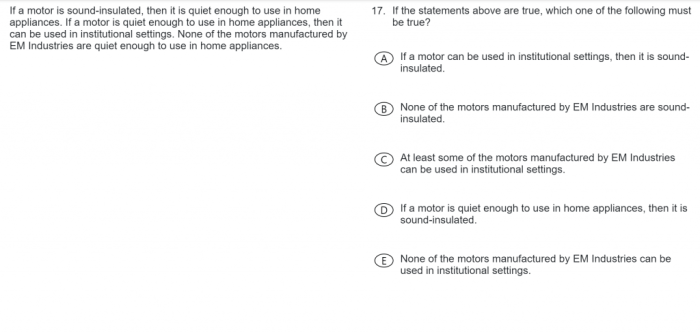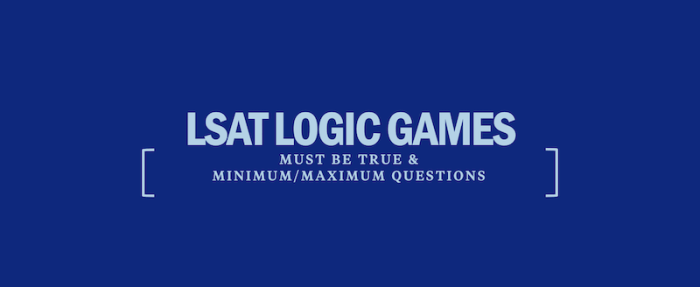LSAT Must Be True questions are an integral part of the LSAT exam, and mastering them is crucial for achieving a high score. These questions test your ability to identify and evaluate key information, eliminate incorrect answer choices, and draw valid inferences.
Embark on this journey with us as we delve into the world of LSAT Must Be True questions, exploring effective strategies, common types, advanced techniques, and tips for practice and improvement.
Introduction

LSAT Must Be True questions are a crucial component of the Law School Admission Test (LSAT). They assess your ability to identify logical implications and draw valid conclusions from a given argument or set of statements. These questions play a significant role in evaluating your critical thinking and reasoning skills, which are essential for success in law school and the legal profession.The
structure of Must Be True questions is straightforward. You will be presented with a brief argument or a set of statements, followed by a question that asks you to identify a statement that must be true based on the given information.
The correct answer choice will be a statement that is logically implied by the premises and cannot be reasonably disputed.
Strategies for Answering LSAT Must Be True Questions

Mastering LSAT Must Be True questions requires a systematic approach. Here are some effective strategies to guide your preparation:
Identifying Key Information
Pinpoint the main claim or argument presented in the question stem. Determine the specific information that must be true for the statement to hold.
- Focus on Necessary Conditions:Identify the essential elements that are indispensable for the conclusion to be valid.
- Eliminate Irrelevant Details:Disregard information that does not directly contribute to the truthfulness of the statement.
Eliminating Incorrect Answer Choices
Scrutinize each answer choice carefully to determine its relationship with the question stem:
- Rule Out Contradictions:Eliminate options that directly contradict the necessary conditions identified in the stem.
- Test for Sufficiency:Select the option that provides information sufficient to make the statement true, even if it is not explicitly stated in the stem.
Remember, the correct answer must be both necessary and sufficient to establish the truth of the statement. Practice these strategies consistently to enhance your accuracy and efficiency in tackling LSAT Must Be True questions.
Common Types of LSAT Must Be True Questions

Must Be True questions are a unique type of LSAT question that requires you to identify a statement that can be logically deduced from the given stimulus. These questions can be challenging, but with the right strategies, you can master them.
There are three main types of Must Be True questions: inferences, assumptions, and strengtheners.
Inferences
Inference questions ask you to identify a statement that can be reasonably inferred from the given stimulus. These questions can be tricky, as you need to be able to identify the underlying assumptions and implications of the stimulus.
For example, consider the following stimulus:
All dogs are mammals.
All mammals have fur.
LSAT Must Be True questions often test our ability to identify the correct answer from a list of options. Similarly, the rule by one crossword clue challenges us to find the right word or phrase that fits the given clue.
Both exercises require us to use our critical thinking skills and knowledge of language to deduce the correct solution.
From this stimulus, we can infer that all dogs have fur. This is because the first statement tells us that all dogs are mammals, and the second statement tells us that all mammals have fur. Therefore, we can conclude that all dogs must have fur.
Assumptions
Assumption questions ask you to identify a statement that is assumed by the given stimulus. These questions can be challenging, as you need to be able to identify the unstated assumptions that underlie the stimulus.
For example, consider the following stimulus:
The government should provide free healthcare to all citizens.
This stimulus assumes that the government has a responsibility to provide for the well-being of its citizens. This assumption is not explicitly stated in the stimulus, but it is necessary for the argument to make sense.
Strengtheners
Strengthener questions ask you to identify a statement that would strengthen the given argument. These questions can be helpful, as they can give you insight into the weaknesses of the argument and how to improve it.
For example, consider the following stimulus:
We should ban all assault weapons.
Assault weapons are dangerous and can cause mass shootings.
This argument could be strengthened by providing evidence that assault weapons are more likely to be used in mass shootings than other types of guns. This evidence would support the claim that assault weapons are dangerous and should be banned.
Advanced Techniques for Complex Must Be True Questions

Complex Must Be True questions on the LSAT often involve multiple inferences or conditional reasoning. Tackling these questions requires careful analysis of the stimulus and consideration of all possible interpretations.
Multiple Inferences, Lsat must be true questions
In questions with multiple inferences, the correct answer choice will be the one that can be logically deduced from the stimulus without relying on any additional assumptions. To approach these questions effectively:
- Identify the key premises and inferences in the stimulus.
- Consider alternative interpretations of the premises and their potential implications.
- Test each answer choice against the inferences you have identified, ensuring that it follows logically without introducing any unwarranted assumptions.
Conditional Reasoning
Conditional reasoning questions present a series of conditional statements and ask you to determine the consequences of those statements. To handle these questions:
- Diagram the conditional statements using a truth table or Venn diagram.
- Identify the possible combinations of truth values for the premises.
- Determine the truth value of the conclusion for each combination of premises.
- Based on the truth table, determine whether the conclusion must be true in all cases.
Practice and Improvement
To excel in LSAT Must Be True questions, consistent practice is paramount. It not only sharpens your analytical skills but also helps you identify areas for improvement.
Effective practice involves reviewing explanations for correct and incorrect answers. This enables you to understand the reasoning behind the correct choice and the pitfalls to avoid. Additionally, timing yourself can help you develop the ability to solve questions efficiently.
Resources for Practice
- Official LSAT PrepTests: The most authentic practice materials available.
- LSAT Prep Books: Comprehensive guides with practice questions and explanations.
- Online Practice Platforms: Offer timed practice tests and detailed analytics.
FAQ Overview: Lsat Must Be True Questions
What is the purpose of LSAT Must Be True questions?
LSAT Must Be True questions assess your ability to identify information that is necessarily true based on the given passage or argument.
What are the different types of LSAT Must Be True questions?
Common types include inferences, assumptions, and strengtheners.
How can I improve my performance on LSAT Must Be True questions?
Practice regularly, review explanations, and focus on identifying key information and eliminating incorrect answer choices.